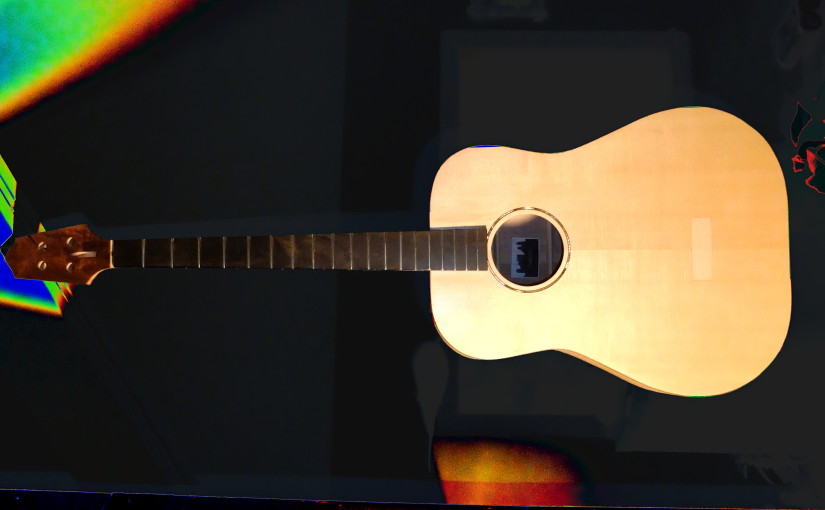A friend who has one of my short-scale electric basses asked me to build him one that he could play acoustically – which became this project. There are several acoustic basses being made that I used to get ideas from. Among the most successfully demonstrated is this Olav Loef guitar played by Martin Tallstrom – Also, a German builder named Christian Stoll builds some good sounding basses –
A Stoll bass appears at 4:32 in the clip below, followed by an Esteve PS 75 –
I compiled some comparison specs for different instruments – appearance of this guitar was important, so odd shapes/sizes/soundhole configurations were ruled out We settled on a dreadnought-guitar-sized body, 30″ scale with 15 frets to the body, and a face-mounted ebony tailpiece with a separate floating bridge/saddle. There are a few acoustic basses that use such a tailpiece/saddle configuration – like the Stoll – with a floating bridge, and a tailpiece that is both glued and through-bolted to the top –
We settled on a dreadnought-guitar-sized body, 30″ scale with 15 frets to the body, and a face-mounted ebony tailpiece with a separate floating bridge/saddle. There are a few acoustic basses that use such a tailpiece/saddle configuration – like the Stoll – with a floating bridge, and a tailpiece that is both glued and through-bolted to the top –  Warwick uses a combined tailpiece/bridge –
Warwick uses a combined tailpiece/bridge –
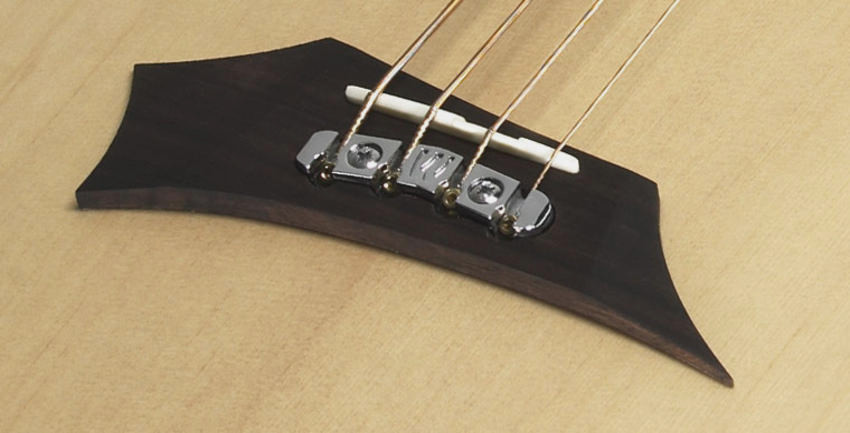
While many good-sounding basses use flat-top steel-string style bridges with bridge pins, that approach doesn’t make a lot of sense to me because of the size of the strings, making that sharp bend, but more importantly to my thinking is the ability to adjust intonation after the fact of installing the bridge. Basses tend to have a lot of angle to the saddle for intonation, and the amount depends also on the kind of strings used. There are bases that use nylon strings as for classical guitar, like the Hannabach strings, and these need much less compensation for intonation than steel strings, like I intend to use (we are going to use Pyramid Gold flat wound strings). The headstock design was based on keeping a minimalist size while giving a straight pull on the strings to the posts. My customer wanted Fender-style knobs, and only Hipshot ultralites would allow us to use this small design, and had the right knobs.
The back and sides are flamed swamp maple, neck block mahogany, tailblock spruce, linings are cherry. I am using a 4-sided, mortise and tenon bolt-on neck joint. The mortise/tenon is tapered on all 4 sides and makes a snug contact fit. The bolts are hanger bolts threaded into the heel of the neck with the nuts and washers inside the guitar body. It was a 4-piece back. Below, sides are in the gluing form, back ready to be glued on.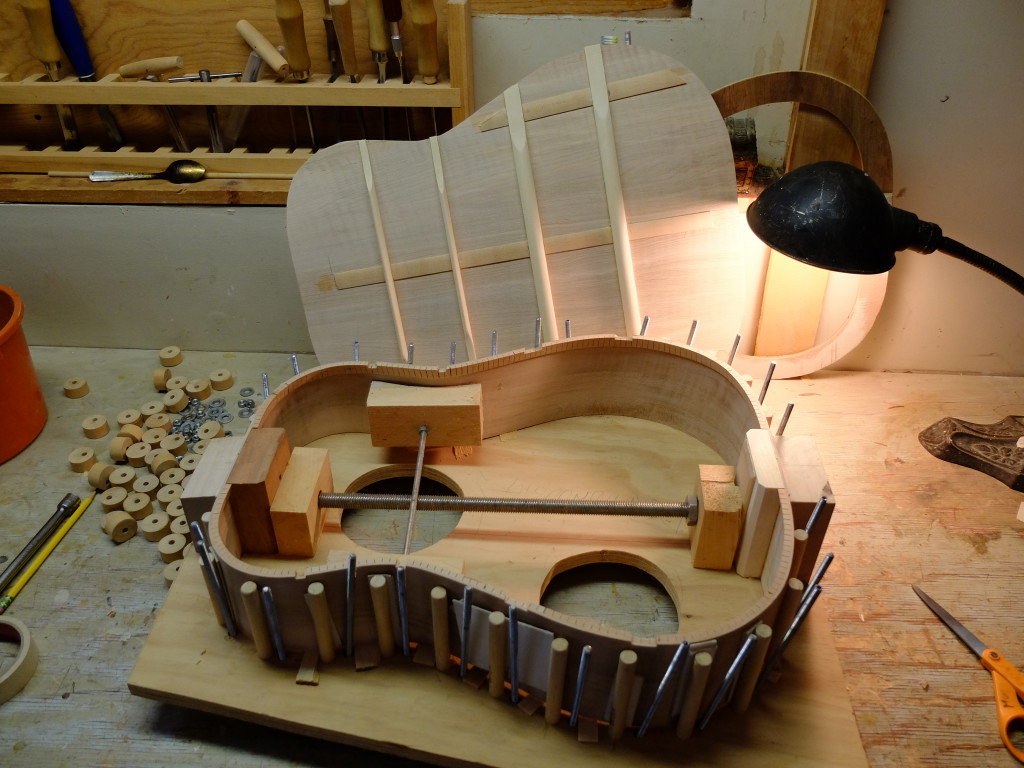 This is the neck in early carving phase. Two-way truss rod, ebony fingerboard, burly black walnut headstock veneer, curly maple neck.
This is the neck in early carving phase. Two-way truss rod, ebony fingerboard, burly black walnut headstock veneer, curly maple neck.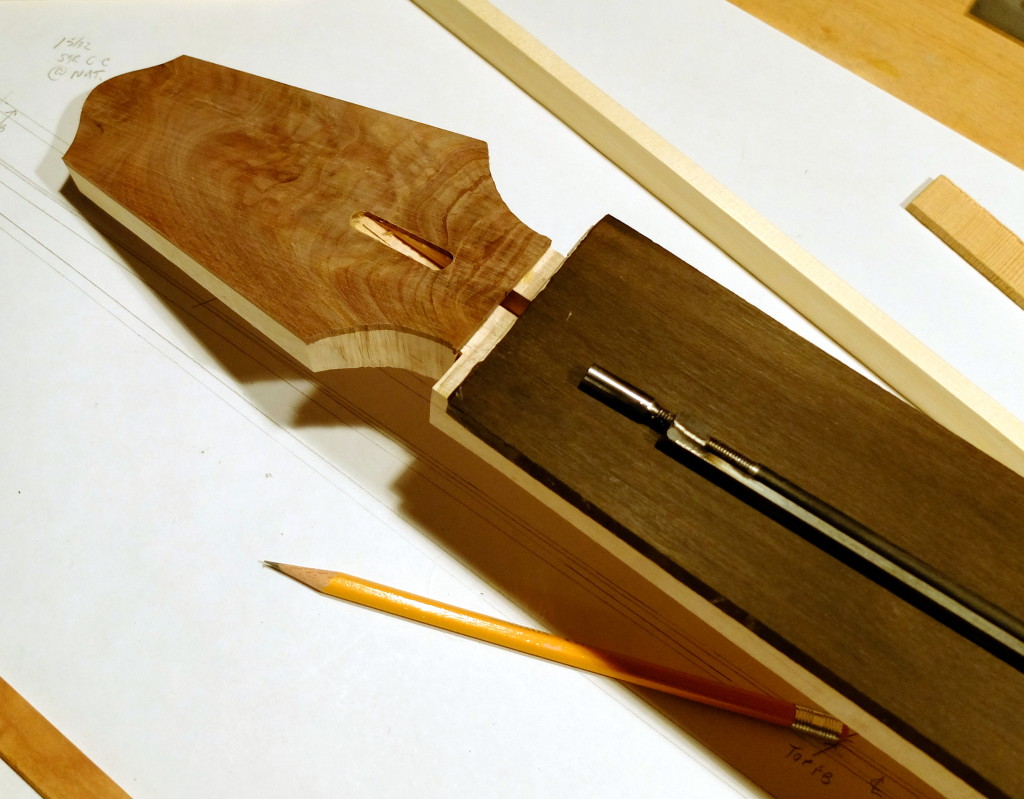
Contrast-enhanced picture of the top bracing. This is a modified X pattern designed to distribute the tension of the strings with the almost direct forward pull on the tailpiece while supporting the bridge. The top is Sitka spruce thicknessed to 0.110″, main braces 5/16″ x 3/4″ before carving. There is a maple plate under the tailpiece location, and the tailpiece will be glued/bolted to the top. The bridge will probably be kind of like an archtop bridge but without the adjustment posts, but have 2 feet that rest above the lower arms of the X. We’ll see!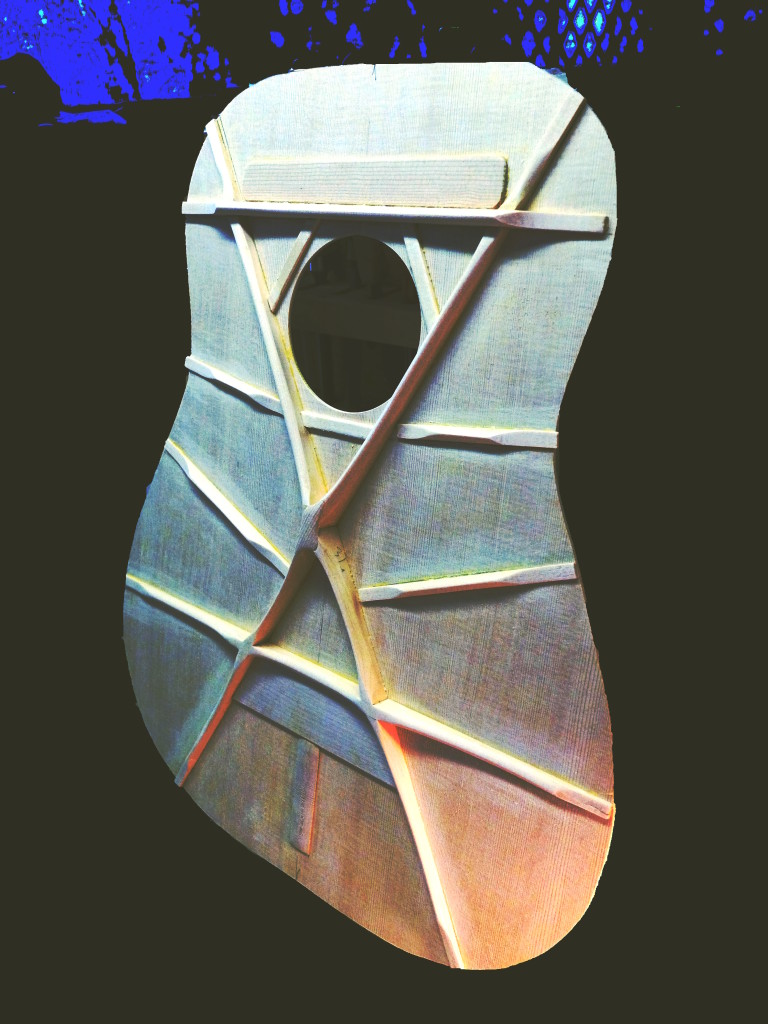 Binding is black walnut with a black/white/black purfling.
Binding is black walnut with a black/white/black purfling.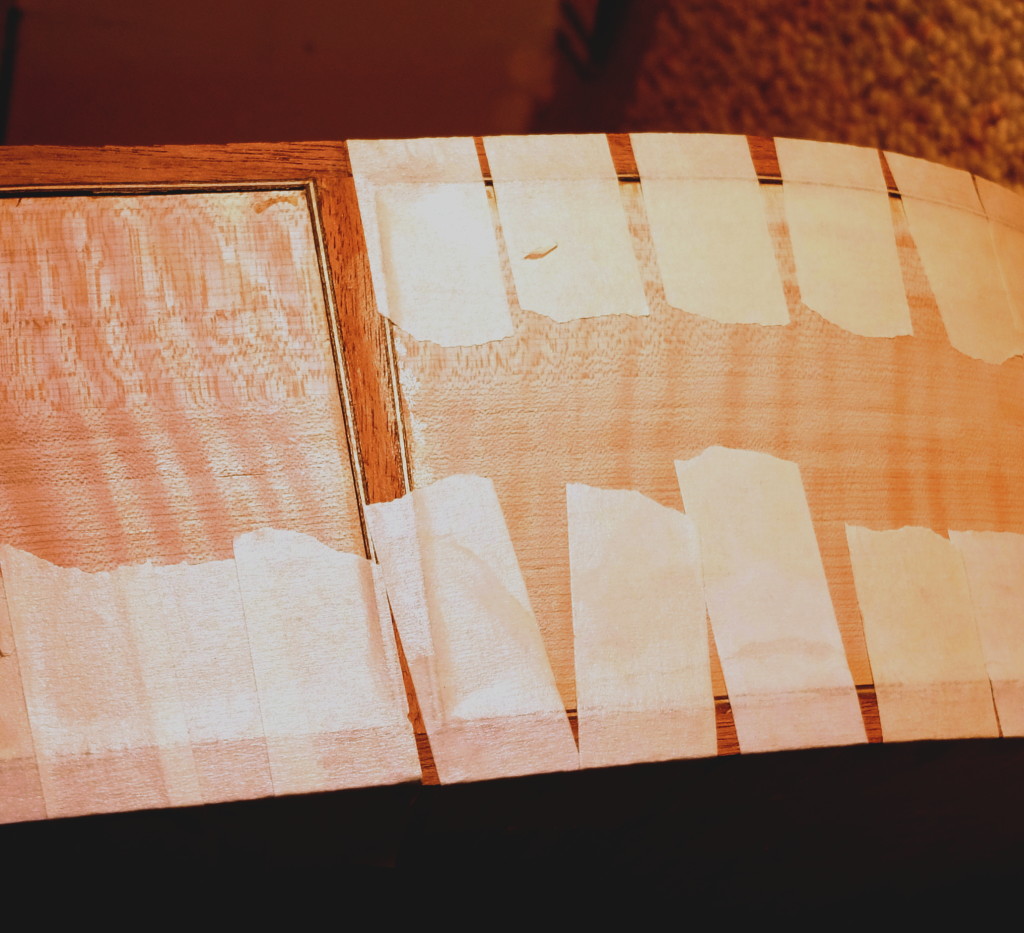 The guitar is in the finishing stages now and will be ready to string up in about 4 weeks. (tailpiece location shown on top, below).
The guitar is in the finishing stages now and will be ready to string up in about 4 weeks. (tailpiece location shown on top, below).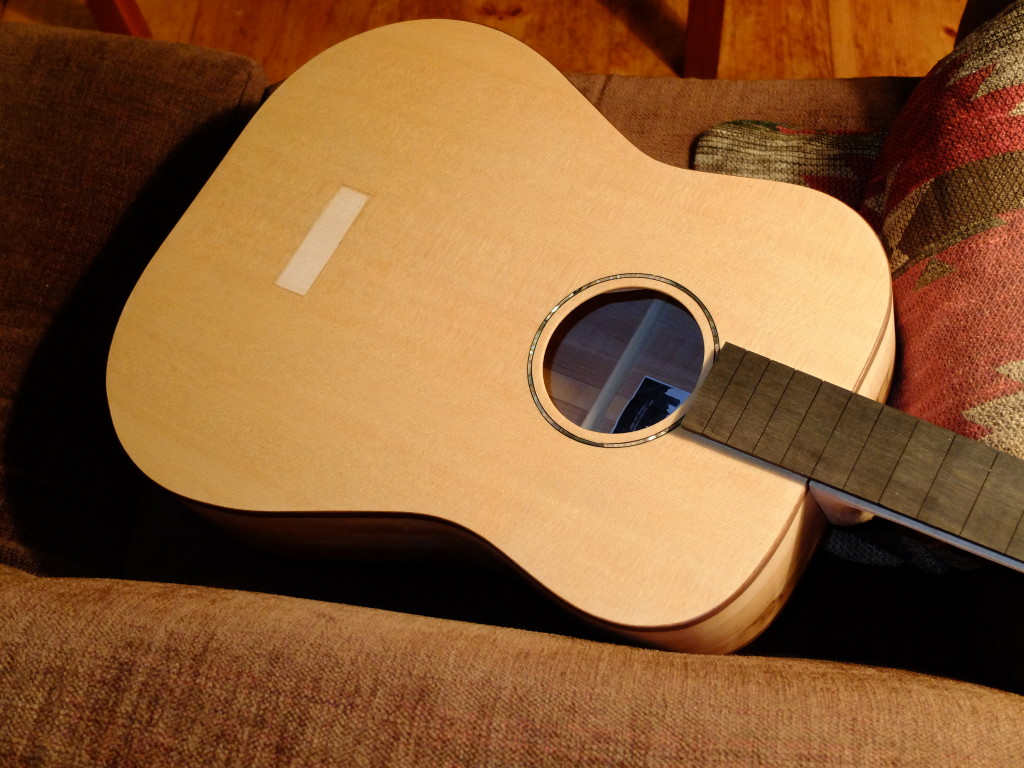 Tailpiece / bridge setup – fixed tailpiece, floating bridge (saddle not made yet)
Tailpiece / bridge setup – fixed tailpiece, floating bridge (saddle not made yet)
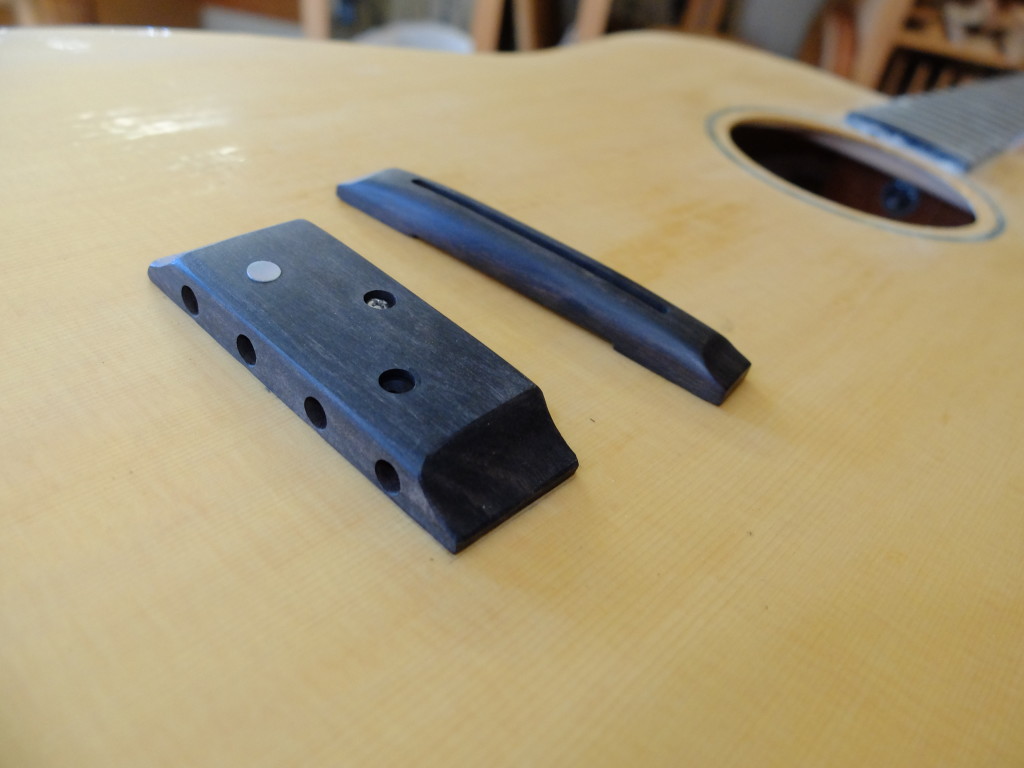 A note on strings – Usable string length is limited on basses to the length of the full-size wrap, which should be long enough to span the distance from the tailpiece to the far side of the nut plus some, but not so long that it reaches to the string post. This means there is somewhat less than 2″ of leeway between a string which is too short and one which is too long. On this bass, which has a 30″ scale, some brands of ‘short scale’ strings fit (Pyramid Golds being one), and some ‘medium scale’ strings also fit (Fender phosphor bronze), while some other ‘short scale’ strings were too short, and some ‘medium scale’ strings were too long. I also found that not all string-end balls are the same size – some are quite a bit bigger than the ones on the Pyramid Golds, for example. I did not anticipate this problem and will make adjustments to the tailpiece in future versions of this guitar specifically to allow certain strings to be used.
A note on strings – Usable string length is limited on basses to the length of the full-size wrap, which should be long enough to span the distance from the tailpiece to the far side of the nut plus some, but not so long that it reaches to the string post. This means there is somewhat less than 2″ of leeway between a string which is too short and one which is too long. On this bass, which has a 30″ scale, some brands of ‘short scale’ strings fit (Pyramid Golds being one), and some ‘medium scale’ strings also fit (Fender phosphor bronze), while some other ‘short scale’ strings were too short, and some ‘medium scale’ strings were too long. I also found that not all string-end balls are the same size – some are quite a bit bigger than the ones on the Pyramid Golds, for example. I did not anticipate this problem and will make adjustments to the tailpiece in future versions of this guitar specifically to allow certain strings to be used.
